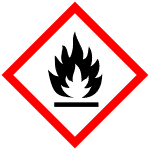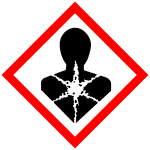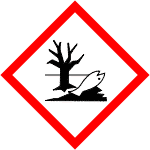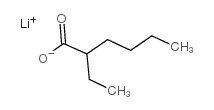2-乙基己酸锂, 99%,Lithium 2-ethylhexanoate
产品编号:西域试剂-WR367881| CAS NO:15590-62-2| 分子式:C8H16LiO2| 分子量:150.14
本网站销售的所有产品仅用于工业应用或者科学研究等非医疗目的,不可用于人类或动物的临床诊断或者治疗,非药用,非食用,
| 英文名称 | Lithium 2-ethylhexanoate |
|---|---|
| CAS编号 | 15590-62-2 |
| 产品沸点 | 228ºC at 760 mmHg |
| 产品闪点 | 116.6ºC |
| 精确质量 | 150.12300 |
| PSA | 40.13000 |
| LogP | 0.95270 |
| 外观性状 | 灰白色粉末 |
| 蒸气压 | 0.027mmHg at 25°C |
| 稳定性 | 常温常压下稳定 避免的物料: 氧化物 |
| 储存条件 | 常温密闭避光,通风干燥 |
相关文档
化学品安全说明书(MSDS)
下载MSDS质检证书(COA)
相关产品
| 符号 |




GHS02, GHS07, GHS08, GHS09 |
|---|---|
| 信号词 | Danger |
| 危害声明 | H225-H304-H315-H319-H336-H410 |
| 警示性声明 | P210-P261-P273-P301 + P310-P305 + P351 + P338-P331 |
| 危害码 (欧洲) | F: Flammable;C: Corrosive;N: Dangerous for the environment; |
| 风险声明 (欧洲) | R11 |
| 安全声明 (欧洲) | 9-16-26-29-33-36/37/39-60-61-62 |
| 危险品运输编码 | UN 1206 3/PG 2 |
| WGK德国 | 1 |
| 海关编码 | 2915900090 |
|
Section 1: Product Identification Chemical Name:Lithium 2-ethylhexanoate, min.98% CAS Registry Number:15590-62-2 Formula:LiOOCCH(C2H5)C4H9 EINECS Number:none Chemical Family:metal carboxylate Synonym:Lithium-2-ethylcaproate, 2-ethylcaproic acid, lithium salt.
Section 2: Composition and Information on Ingredients IngredientCAS NumberPercentACGIH (TWA)OSHA (PEL) Title Compound15590-62-2100%no datano data Section 3: Hazards Identification Irritating to skin, eyes and respiratory tract. Lithium salts are toxic to the central nervous system and on Emergency Overview: repeated ingestion may damage kidneys and act as a teratogen Primary Routes of Exposure:Ingestion, Inhalation of dust. Eye Contact:Causes slight to mild irritation of the eyes Skin Contact:Causes slight to mild irritation of the skin. Inhalation:Irritating to the nose, mucous membranes and respiratory tract. Ingestion:Ingestion may lead to dizziness, abdominal cramps, vomiting, bloody diarrhea, weakness, and convulsions. Acute Health Affects:Lithium salts are toxic to the central nervous system. Irritating to skin, eyes and respiratory tract. Chronic Health Affects:May cause kidney damage. May be a teratogen. NTP:No IARC:No OSHA:No SECTION 4: First Aid Measures Immediately flush the eyes with copious amounts of water for at least 10-15 minutes. A victim may need Eye Exposure: assistance in keeping their eye lids open. Get immediate medical attention. Wash the affected area with soap and water. Remove contaminated clothes if necessary. Seek medical Skin Exposure: assistance if irritation persists. Remove the victim to fresh air. Closely monitor the victim for signs of respiratory problems, such as difficulty Inhalation: in breathing, coughing, wheezing, or pain. In such cases seek immediate medical assistance. Ingestion:Seek medical attention immediately. Keep the victim calm. Give the victim water (only if conscious). SECTION 5: Fire Fighting Measures Flash Point:not applicable Autoignition Temperature:none Explosion Limits:none Extinguishing Medium:carbon dioxide, dry powder or foam If involved in a fire, fire fighters should be equipped with a NIOSH approved positive pressure self-contained Special Fire Fighting Procedures: breathing apparatus and full protective clothing. Hazardous Combustion andIf involved in a fire this material may emit toxic organic fumes and toxic lithium carbonate dust. Decomposion Products: Unusual Fire or Explosion Hazards: No unusual fire or explosion hazards. SECTION 6: Accidental Release Measures Spill and Leak Procedures:Small spills can be mixed with vermiculite or sodium carbonate and swept up. SECTION 7: Handling and Storage Handling and Storage:Store in a sealed container. Keep away from heat and moisture. SECTION 8: Exposure Controls and Personal Protection Eye Protection:Always wear approved safety glasses when handling a chemical substance in the laboratory. Skin Protection:Wear appropriate chemical resistant gloves and protective clothing. Ventilation:Material may form a fine dust. If possible, handle the material in an efficient fume hood. If in form of fine dust and ventilation is not available a respirator should be worn. The use of respirators Respirator: requires a Respirator Protection Program to be in compliance with 29 CFR 1910.134. Ventilation:Material may form a fine dust. If possible, handle the material in an efficient fume hood. Additional Protection:No additional protection required. SECTION 9: Physical and Chemical Properties Color and Form:off-white pwdr. Molecular Weight:150.15 Melting Point:no data Boiling Point:no data Vapor Pressure:no data Specific Gravity:no data Odor:none Solubility in Water:soluble SECTION 10: Stability and Reactivity Stability:air and moisture stable solid Hazardous Polymerization:no hazardous polymerization Conditions to Avoid:none Incompatibility:oxidizing agents Decomposition Products:Carbon dioxide, carbon monoxide, organic vapors, and metal oxides and carbonates. SECTION 11: Toxicological Information RTECS Data:No information available in the RTECS files. Carcinogenic Effects:No data available Mutagenic Effects:No data available Tetratogenic Effects:No data available SECTION 12: Ecological Information Ecological Information:No information available SECTION 13: Disposal Considerations Disposal:Dispose of according to local, state and federal regulations. SECTION 14: Transportation Shipping Name (CFR):Non-hazardous Hazard Class (CFR):NA Additional Hazard Class (CFR):NA Packaging Group (CFR):NA UN ID Number (CFR):NA Shipping Name (IATA):Non-hazardous Hazard Class (IATA):NA Additional Hazard Class (IATA):NA Packaging Group (IATA):NA UN ID Number (IATA):NA SECTION 15: Regulatory Information TSCA:Listed in the TSCA inventory. SARA (Title 313):Title compound not listed. Second Ingredient:none SECTION 16 - ADDITIONAL INFORMATION N/A |








 浙公网安备 33010802013016号
浙公网安备 33010802013016号